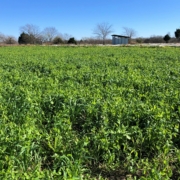Carbon Farm Planning
By Elise Haschke, Climate and Agriculture Program Manager, and Darron Gaus, Sustainable Agriculture Specialist
It’s early Fall on New Leaf Agriculture, a USDA-certified organic, diversified, specialty crop farm in Central Texas. New Leaf grows vegetables, fruits, fiber, and natural dye plants, along with raising pastured eggs. We’re walking the farm alongside its director, Matt Simon, and identifying all opportunities for carbon capture and storage on the farm. This journey is part of the creative Carbon Farm Planning process, which maps every square foot of a farm property and paints the picture of an abundantly fertile working landscape through the adoption of conservation practices that maintain living roots, integrate agroforestry systems, minimally disturb the soil, utilize alternative soil amendments, and incorporate species diversity.
Carbon Farm Planning is a comprehensive conservation planning framework that centers carbon as the organizing principle on working lands. Developed by Carbon Cycle Institute in 2014, Carbon Farm Planning recognizes that solar energy is the main driver of agroecosystem dynamics and that carbon is the carrier of that energy. In partnership with Carbon Cycle Institute, NCAT is expanding this planning framework into Texas with funding from Southern Sustainable Agriculture Research and Education (SSARE) and The Meadows Foundation.
A Carbon Farm Plan begins with the farm goals, historical and current land use, and a full site assessment of soils, hydrology, climate conditions, wildlife, and resource concerns. The Planner and producer then work together to identify all opportunities for enhanced carbon capture and storage with concurrent co-benefits, including greater adaptation to extreme weather, improved water-holding capacity, biodiversity, and productivity. NRCS conservation practices are then selected and the greenhouse gas benefits of selected practices are quantified using the COMET tool. The final Carbon Farm Plan report includes a table of recommended practices and implementation guidelines.
Each farm’s Plan is an adaptive tool intended to support producer decision-making over time. It is a living, malleable document with neither rigid timelines nor contractual agreements. The canvas is soon full of new ideas and practices that the farmer and Planner agree are best for farm goals and carbon sequestration capabilities. It is now time to look at how these brush strokes come to life at the farm.
Back on New Leaf, we observe two fields in particular that have been struggling to produce annual crops. What’s happening in these fields to compromise soil health and productivity? We bent down and scooped small handfuls of moist Wilson clay loam in our hands. Preliminary soil tests had revealed slightly basic, calciferous soil with low levels of potassium. The immediate recommendation was to apply potassium sulfate, K-Mag, and Azomite to begin decalcifying the soil and lowering the pH. This process can take up to six months. Meanwhile, NCAT’s Darron Gaus recommended a longer-term regenerative strategy to re-balance the soil microbiome. The four-step succession begins with broadcasting cover crop seeds to establish living roots and aerate the soil with large root system species. Two months later, the cover crop stand is to be mowed low, but kept alive, and grazed by the farm’s 150 chickens in order to avoid disruptive tillage and to work natural fertilizer into the soil. Grazing is followed by another low mowing and a 6-inch application of compost. Then transplants or large seeded direct seeding of annual cash crops goes directly into the compost.
Matt recently summarized the process to an interested audience as working with a team of carbon farming technical assistance providers to help the farm get “real” about practice goals, offer accountability, and align practices with NRCS standards while distinguishing the farm with specifics that intrigue customers and provide values-added integrity.
Additional recommendations for New Leaf include planting windbreaks in the direction of the prevailing northerly winter winds and southeasterly summer winds, establishing pollinator hedgerows and multi-story cropping orchard fields, prescribed grazing throughout the farm, and planting conservation cover and herbaceous wind barriers along the berms and swales. Down the road, biannual soil samples will be collected per NCAT’s Soil for Water soil sampling protocol and sent off to Regen Ag Labs to monitor and track soil health indicators over time.
Now the painting starts taking on real-life animation. Matt and the New Leaf team, including refugees through the Multicultural Refugee Coalition who have been given “the potential to thrive in their new communities through dignified, fair-wage work,” all begin work on implementation of the Carbon Farm Plan practices. New Leaf’s already rich, diversified farm begins to take a new, breathtaking approach toward carbon sequestration. A beautiful food forest has begun to take shape in Central Texas, thanks to CCI and the Carbon Farm Planning process. New Leaf has already enhanced the new thought process with fresh ideas, all while growing fresh produce and sustainable products that will provide unmeasurable benefits to the surrounding communities.
To learn more about Carbon Farm Planning, register for our annual conference, Growing Hope: Practical Tools for Our Changing Climate. This free, virtual convening will feature Carbon Cycle Institute and producers with a Carbon Farm Plan on Tuesday, February 28. If you would like to reach out to us about potential Carbon Farm Planning at your farm, ranch, or land stewardship project, email darrong@ncat.org. If you would like to discuss carbon in your operation with other like-minded peers, post your question or comments to the ATTRA forum.
Related ATTRA Resources
Episode 284. Carbon Farm Planning
ATTRA Annual 2023 Conference, Growing Hope: Practical Tools for Our Changing Climate
Other Resources
Multicultural Refugee Coalition



 USDA photo by Scott Bauer
USDA photo by Scott Bauer